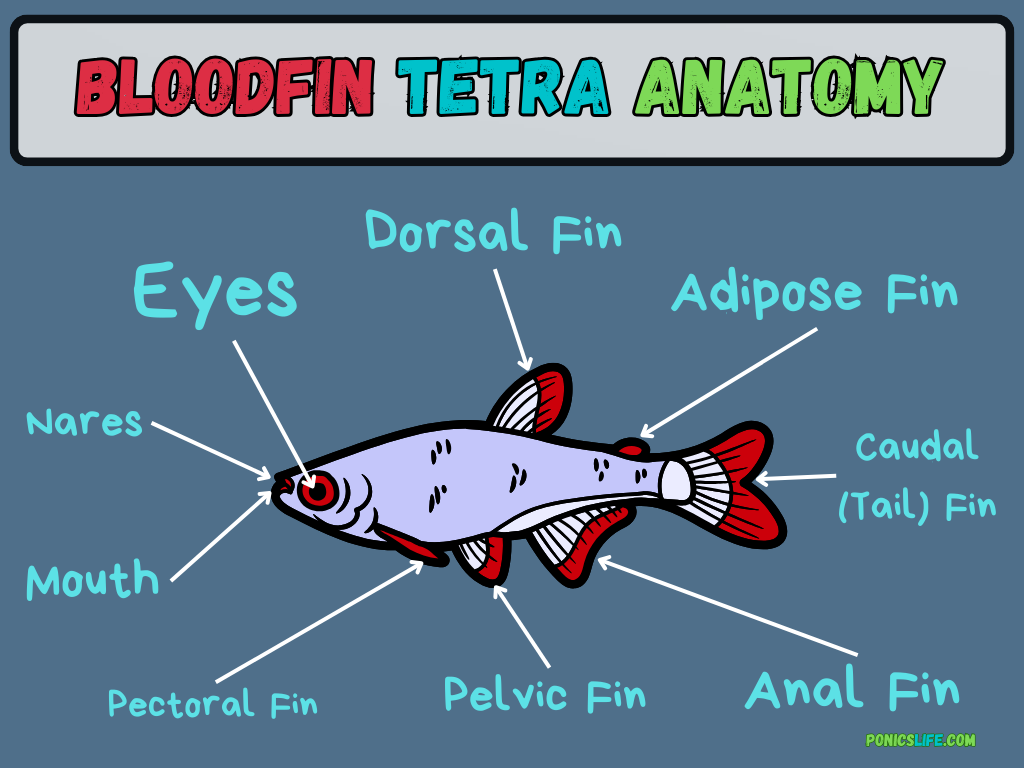Bloodfin Tetra
Description: Bloodfin Tetras (Aphyocharax anisitsi) are a captivating species distinguished by their silvery-blue body and vivid blood-red fins, with some displaying red dorsal and pelvic fins while others have translucent qualities. Reaching a maximum size of about 2.2 inches (5.5 cm), they are among the larger Tetra species, suitable for both novice and experienced aquarists due to their adaptability to a range of environmental conditions. Their striking appearance is further enhanced in well-maintained aquarium settings, showcasing their lively shoaling behavior.
Temperament: Bloodfin Tetras are generally peaceful but can exhibit fin-nipping tendencies, especially towards fish with elaborate fins such as Angelfish or Guppies. They thrive in groups of six or more, which helps minimize aggressive behavior and promotes a harmonious community tank environment. When kept with suitable companions, particularly agile and short-finned species, they contribute to a dynamic and engaging aquarium.

Identification
Bloodfin Tetra
Common Name: Bloodfin Tetra
Other Names: Redfin Tetra, True Bloodfin
Scientific Name: Aphyocharax anisitsi
Order: Characiformes
Family: Characidae
Genus: Aphyocharax
Species Facts
Bloodfin Tetra
Temperament: Generally Peaceful
Max Size: 2.2 inches (5.5 cm)
Fish Origin: Brazil, Paraguay, Uruguay, Argentina
Diet: Omnivore
Reproduction: Egg Scatterer
Max Lifespan: Around 5 Years
Tank Care
Bloodfin Tetra
Environment: Freshwater
pH: 6.0 – 8.0
Hardness: 54 – 447 ppm
Temperature: 64° – 82° F (18° – 28° C)
Minimum Tank Size: 30 gallons for 6 fish
Recommended # in group: at least 6
Care and Habitat
Bloodfin Tetra Care: For Bloodfin Tetras, an aquarium with a dark substrate and ample vegetation, along with a tightly secured lid to prevent jumping, creates an ideal habitat. A minimum tank size of about 30 gallons can accommodate a small group, ensuring they have enough space to exhibit natural behaviors. Water parameters should be maintained within a pH of 6.0 to 8.0 and a temperature range of 64° – 82° F (18° – 28° C) to keep them healthy and vibrant. Effective filtration and gentle water movement mimic their natural riverine habitats, supporting their well-being. Regular water changes and monitoring of water quality are essential to maintain their environment.
Difficulty: Bloodfin Tetras are considered an excellent choice for beginners due to their hardiness and adaptability to a wide range of aquarium conditions. Their easy-going nature, combined with striking appearance, makes them a rewarding choice for those new to the hobby.
Tankmates: Bloodfin Tetras are peaceful yet may occasionally nip at long-finned or slow-moving fish, making them well-suited for community tanks with other characids, Corydoras catfish, and small Loricariids. It’s recommended to keep them in groups of at least six for a harmonious environment, avoiding tankmates with very elaborate finnage to minimize the risk of fin-nipping.
Bloodfin Tetra Diet: Bloodfin Tetras are not picky eaters, accepting a variety of dried, frozen, and live foods. A balanced diet including flakes or micro pellets supplemented with live foods like bloodworms, mosquito larvae, and brine shrimp promotes their health. Regular feeding of high-quality, nutrient-rich food supports their vibrant coloration and energy levels.
Male vs Female: Distinguishing between male and female Bloodfin Tetras is relatively straightforward; males display more vibrant colors with a white edge on their anal and pelvic fins and a hook-shaped anal fin. Females, in contrast, have a more rounded appearance and exhibit less striking coloration. This sexual dimorphism not only aids in identification but also adds to the visual interest of the species in aquariums.
Natural Habitat: Bloodfin Tetras originate from the freshwater streams and river tributaries of the Paraná River basin across Brazil, Paraguay, and Argentina. Their natural habitats are characterized by tranquil waters, shaded by dense aquatic vegetation, providing a serene environment. Recreating a similar environment in captivity, with areas of dense and floating vegetation, encourages natural behaviors and well-being.

IUCN Red List Status: The Bloodfin Tetra is categorized as Least Concern (LC) by the International Union for Conservation of Nature (IUCN), which means that it does not currently qualify as Critically Endangered, Endangered, Vulnerable, or Near Threatened.
Reproduction: In the breeding process, Bloodfin Tetras prefer seclusion, with a breeding tank setup including dim lighting and abundant plant life. They are oviparous, with females laying between 300 and 500 transparent eggs, which hatch within 24 hours, necessitating removal of the adults to prevent egg predation. Initially, fry should be fed infusoria, progressing to baby brine shrimp as they grow. This species is known for its fecundity, potentially resulting in several hundred fry from a single spawning event.

Aquaponic Considerations
| Can be used for Aquaponics | Yes |
| Indoor or Outdoor | Indoor Aquarium |
| Ornamental or Edible | Ornamental |
| Stocking Density | 6 fish per 30 gallons |
To learn more about Aquaponics, explore our Aquaponics Information and Hobby Center.
FAQs
Where did this information come from?
The primary resources used for this article include USGS, the IUCN Red List of Threatened Species, FishBase, the U.S. Fish and Wildlife Service, and other aquarium databases.
How often should I feed my fish?
Aquarium fish generally require feeding once or twice a day. It’s important to provide only as much food as they can consume within a few minutes to prevent overfeeding and potential water quality issues. Adjust the feeding schedule and quantity based on the fish’s activity level and the water temperature, as their metabolism slows down in cooler conditions.
How do I choose compatible tankmates for my aquarium?
When selecting tankmates, consider the temperament, size, and dietary needs of the fish. Peaceful species that grow to similar sizes and have comparable dietary requirements usually make good companions. Avoid pairing aggressive or fin-nipping species with slow-moving or long-finned fish. Researching each species’ behavior and needs is key to creating a harmonious aquarium.
What is the ideal number of fish for my aquarium?
The “one inch of fish per gallon” rule is a common guideline, but it oversimplifies the complexity of maintaining a healthy aquarium. Factors such as the species’ adult size, behavior, and the tank’s filtration capacity are crucial. Start with a conservative number of fish and increase gradually, ensuring the aquarium’s biological filter can handle the waste load.
What should I do if my fish show signs of stress or illness?
First, check your water quality parameters (temperature, pH, ammonia, nitrites, and nitrates) and make sure they’re within the ideal range for your fish. Stress and illness often stem from poor water quality or incorrect temperatures. Isolate sick fish if possible, research their symptoms to identify the issue, and treat accordingly with medication or by adjusting the water conditions. You can read more about fish stress here.
How important is lighting in an aquarium?
Proper lighting is essential for simulating natural daylight cycles, which help regulate fish behavior and physiological functions. It’s also critical for the growth of live plants, which rely on light for photosynthesis. Use aquarium-specific lights and set them on a timer to provide your fish and plants with a consistent light-dark cycle.
Can plants and decorations affect my fish?
Yes, live plants can greatly benefit an aquarium by providing oxygen, hiding places, and natural boundaries that help reduce stress in fish. Decorations should be chosen with care to avoid sharp edges that could injure fish. Ensure all items are safe for aquarium use to avoid contaminating the water.






